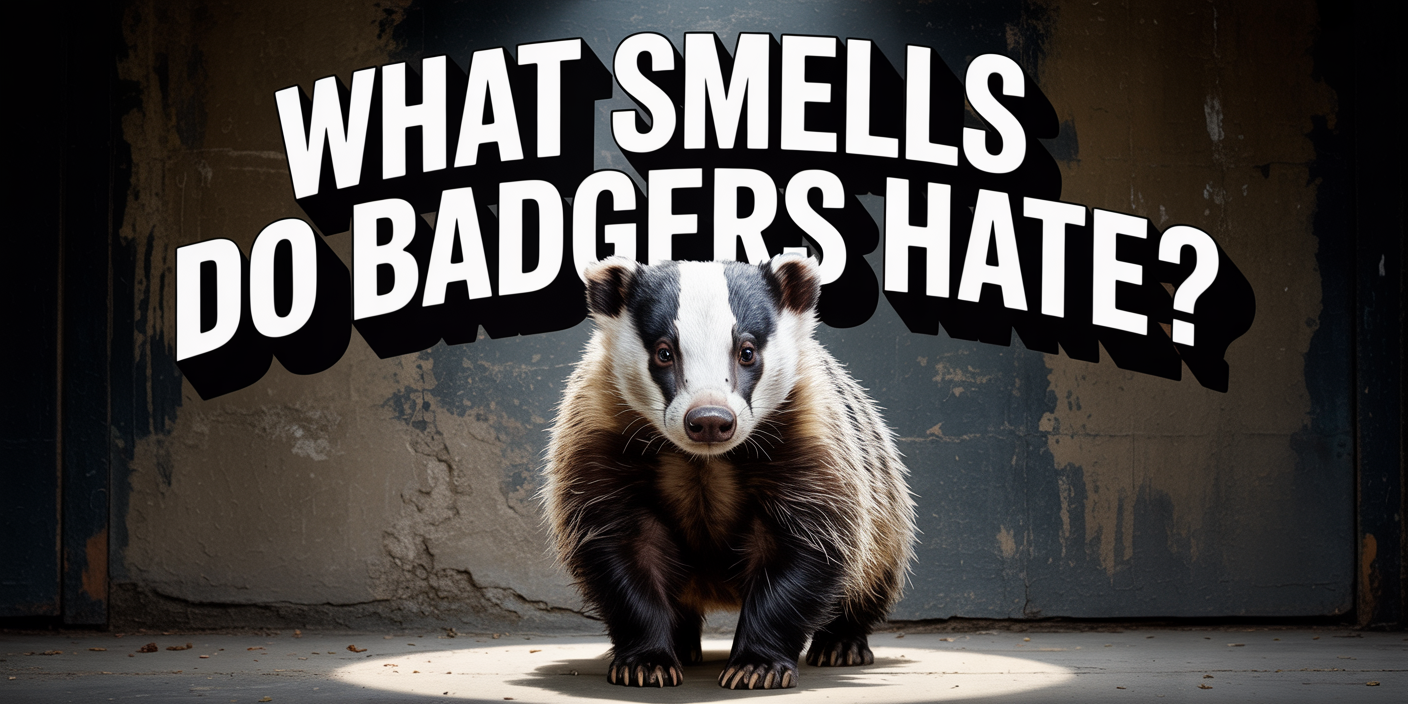Badgers hate strong, pungent smells like ammonia, garlic, chili pepper, citronella, and predator urine, which overwhelm their sensitive noses and signal danger. These scents can help deter them from digging or nesting in unwanted areas.
If your yard’s starting to look like a badger’s personal buffet, you’re not alone. These nocturnal diggers can turn a neat lawn into a mess of snuffle holes and torn-up turf overnight. The good news? Their powerful sense of smell is also their biggest weakness.
At AAAC Wildlife Removal, we’ve dealt with enough badger break-ins to know that certain smells send them packing fast. This article breaks down exactly what smells badgers hate, why those scents work, and how to use them effectively. Whether you’re dealing with a stubborn digger or just want to make your property less inviting, you’ll find practical tips right here, no fluff, no guesswork, just proven odor-based defense.
Meet the Badger’s Nose: Why Scent Is the Key to Deterrence
Badgers don’t see the world the way we do, they smell it. Their sense of smell is one of the strongest in the animal kingdom, estimated to be hundreds of times more sensitive than ours. That ultra-powered snout is their main tool for sniffing out grubs, earthworms, and nesting spots, even under thick soil or concrete slabs.
This super-scent ability makes badgers highly reactive to odors in their environment, especially those that signal danger or discomfort. Strong, unnatural smells confuse or overwhelm their foraging behavior, making the area feel unsafe or uninhabitable. In short: if it smells terrible to a badger, they’ll likely think twice about sticking around.
That’s why scent-based repellents can work so well, but only when you understand how badgers interpret smells and how long those deterrents last. Let’s break down the specific scents that send them running and how to apply them with strategy, not guesswork.
Top Smells That Repel Badgers And Why They Work
Badgers have one of the most finely tuned noses in the animal kingdom, and that means they’re extremely picky about what they’ll tolerate in their environment. While they might be stubborn diggers, they’re also quick to back off if a scent triggers their discomfort or survival instincts. Below are the most effective scents used to keep badgers at bay, plus how to use them without overdoing it.
Ammonia: Mimics Predator Urine
Ammonia tops the list for a reason. It closely mimics the smell of urine from predators like foxes, which immediately puts badgers on high alert. A whiff of ammonia tells them this territory might already be claimed, or worse, dangerous.
Soak old rags or cotton balls in ammonia and place them near known digging spots, burrow entrances, or along fences. Just be sure to keep it away from plants and pets, and always reapply after heavy rain. For best results, combine with physical barriers to reinforce the message.
Citronella and Eucalyptus: Overpowering and Unpleasant
These oils are overwhelming for most animals, but for badgers, they’re a sensory overload. Citronella and eucalyptus interfere with how they process scent trails, making it nearly impossible for them to sniff out food or navigate comfortably.
You can apply diluted essential oil sprays around entry points, trash bins, or garden beds. Bonus: they double as mosquito repellents for you. Just avoid spraying directly on grass or flowers, as the oils can cause some plant irritation over time.
Garlic and Chili Pepper: Nature’s Nuisance Combo
This fiery duo doesn’t just smell bad, it burns. Chili powder irritates a badger’s nasal passages, while garlic leaves a lingering, pungent scent that messes with their tracking instincts. It’s the kind of smell that tells them, “You’re not welcome here.”
You can make your own mix by boiling crushed garlic and chili flakes in water, letting it cool, and spraying it on affected areas. It’s a cheap, pet-safe option if you’re dealing with mild activity and want a low-risk test.
Predator Urine: A Signal They Can’t Ignore
Fox, coyote, or wolf urine (available in pellet or liquid form from garden centers) taps directly into a badger’s fear response. When they smell a dominant predator in the area, they’re much less likely to stay or dig around.
Apply it at night along fence lines or near burrow entrances. Reapply every few days and after rain. While it may sound a bit wild, this method works better than most chemical options on deeply territorial badgers.
Commercial Repellents: Read the Ingredients First
There are dozens of over-the-counter badger repellents claiming to work, but most only do if the ingredients are spot-on. Look for products containing capsaicin, castor oil, or napthalene. These substances either irritate the badger’s senses or coat soil in a way that deters digging.
Always follow label instructions and avoid over-saturating your soil. Some repellents can actually attract other animals if misused, so pairing them with a proper removal strategy (like what AAAC offers) is a safer long-term solution.
Smell Alone Isn’t Enough: Common Mistakes Homeowners Make
Using strong scents might send badgers running at first, but if you don’t use them strategically, those results won’t last. We’ve seen plenty of frustrated homeowners try every smelly substance under the sun, only to wake up to new holes in the yard. The key? Avoiding these common mistakes when applying scent-based deterrents:
- Ignoring Entry Points: If you’re not targeting the actual spots where badgers are entering or digging, you’re just scenting random soil. Always locate burrows, broken fencing, or trails and apply your deterrents precisely where they’re needed.
- Overusing Strong Chemicals: Too much ammonia or essential oil can harm your plants, pets, or even your own nose. More isn’t better. Use just enough to irritate the badger without creating a hazard.
- One-Time Application Mentality: Rain, wind, and time can wash away even the strongest smell. You need to reapply most deterrents every few days, especially after weather events.
- Skipping Physical Barriers: Smells can delay digging, but they won’t stop a determined badger forever. If your lawn is basically an all-you-can-eat worm buffet, consider combining scents with fencing, soil mesh, or gravel to block access.
- Treating Repellents Like a Cure-All: Repellents work best when you’re disrupting new activity. If a badger’s already built a den under your shed, you’ll likely need professional intervention to relocate them safely.
Signs a Badger Is Already Settled on Your Property
Sometimes, the smell trick is just too late. If a badger has already claimed your yard, you’ll notice a few not-so-subtle signs. Knowing what to look for can help you decide if it’s time to stop DIY efforts and let professionals step in.
Torn-Up Turf and Cone-Shaped Holes
Badgers love to dig, especially for worms and beetle larvae. You’ll often spot V-shaped or cone-like holes scattered across your lawn, especially in soft, damp soil. If your perfectly trimmed grass suddenly looks like Swiss cheese, it’s a red flag.
They can dig through flower beds, raised gardens, and even gravel. The digging isn’t just a mess, it’s a sign they’re actively foraging and have made your property part of their routine.
Musky Odors Near Fences or Sheds
Badgers have scent glands they use to mark their territory, and once they start nesting, you might notice a low-key musky or earthy smell in concentrated areas. It’s not overpowering, but it lingers.
This smell usually shows up near fences, garden edges, or under decking where badgers are sheltering. If you catch an odd odor and can’t trace it to trash or pets, a badger might be the culprit.
Nocturnal Activity and Garden Disruption
Since badgers are mostly active at night, you might not catch them in the act, but you’ll definitely see the aftermath. Knocked-over planters, scratched-up compost bins, or disturbed garbage are classic signs of night visits.
If you set up a motion-activated camera, you’ll likely spot their lumbering walk around 11PM to 4AM. Regular late-night disruptions usually mean they’re nesting close by.
Tunnels or Burrow Entrances
One of the clearest signs is a burrow, or several, often hidden under sheds, porches, or behind garden structures. Badger setts have large entrances, sometimes up to 10 inches wide, and they’re usually surrounded by loose soil.
If you find fresh soil piles or tunnels with claw marks near them, don’t block them off. That could trap the badger inside and cause a bigger problem. This is where calling in AAAC Wildlife Removal becomes essential.
Latrine Pits or Scattered Droppings
Badgers dig shallow pits to use as communal toilets, usually filled with small, tubular droppings. These latrine sites are often placed along boundaries, garden paths, or near their den.
If you spot multiple little pits that weren’t there last week, and they’ve got droppings inside, it’s a strong indicator of an active sett nearby. Most homeowners mistake this for another animal until it becomes a routine mess.
Keep Your Yard Badger-Free: Smarter Long-Term Solutions
Once a badger finds a yard it likes, chances are it’ll be back unless you make some real changes. Scent-based deterrents are helpful, but they’re only one part of a larger strategy. To truly keep badgers away, you need to disrupt what’s attracting them in the first place.
Start by making your yard less appealing from the ground up. Here’s how:
- Eliminate Their Food Source
Grubs and earthworms are a buffet for badgers. Apply non-toxic lawn treatments to reduce grub populations and keep your soil dry when possible. Avoid overwatering, soft ground makes digging easier. - Reinforce Physical Barriers
Install badger-proof fencing by digging mesh at least 12–18 inches underground and angling it outward. You can also use gravel layers under vulnerable areas like sheds or compost piles. - Use Scent as a Redirect, Not a Crutch
Rather than drenching your yard in strong smells, place them in spots that push badgers away from key areas. For example, you can use citronella near gardens and predator urine along fence lines to guide movement without overwhelming your entire property. - Secure Garbage, Compost, and Pet Food
Badgers won’t say no to a free snack. Lock down trash bins, avoid open compost heaps, and never leave pet food outside overnight. These simple habits can stop attracting wildlife in the first place. - Schedule Regular Yard Inspections
Look for early signs like shallow holes or faint trails. Catching badger activity early gives you more options before it turns into full-on turf destruction.
Smart prevention isn’t just about keeping badgers out, it’s about making your yard less of a target. These steps, paired with professional support from AAAC Wildlife Removal, give you the upper hand.
Out-Stinking the Badger Without Stress
Badgers may be bold diggers, but their sensitive noses are no match for the right smells used the right way. Scents like ammonia, garlic, chili pepper, and predator urine can make your yard a sensory nightmare for them, if you apply them with strategy and consistency.
Still, smell alone isn’t a magic fix. If the digging’s already started or you’re dealing with nightly damage, it’s time to call in the pros. At AAAC Wildlife Removal, we don’t just chase badgers off, we keep them from coming back. Our team knows exactly how to handle badgers in Palm Bay and across Florida, using safe, humane methods that work for the long haul.
Why Call AAAC Wildlife Removal in Phoenix?
Don’t let a badger turn your Phoenix property into a nightly excavation site. At AAAC Wildlife Removal, we offer safe, humane badger removal backed by expert knowledge of Arizona’s unique desert terrain and wildlife behavior. If you’ve noticed digging, odd smells, or signs of a sett, our Phoenix team is ready to step in and handle it the right way. Give us a call and let’s make sure badgers get the message loud and clear, your yard isn’t open for business.




